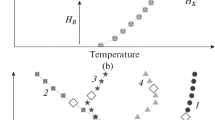Summary
Nocturnal cooling of the lower troposphere is considered in this paper with the view ofa) testing the performances of our model, giving the temperature profile under a radiative inversion, by comparing its forecasting to the Wangara data;b) better understanding the mutual contributions of radiative and turbulent mechanisms of heat transfer into the lower atmospheric layer;c) defining the more appropriate length scales of the heat transfer process. The average agreement between the nocturnal vertical temperature distributions and the values predicted by our model was found to be good. The matching of different results given by the radiation laws and the application of a heat diffusion model, parametrized by us, to the real situations measured in the Po Valley (Italy) and during Wangara experiment show that a turbulent contribution to heat redistribution in the first few hundred metres of air, opposite to the net radiative flux of the earth surface, is needed, but its effect is to be felt not in the same (lowest) layers near the ground where the radiation transfer is dominating. The application of our diffusion model to the Wangara experimental data also shows that the length scale, defined in terms of heat diffusion coefficient and time, represents as good a reference parameter as other «heat flux history» scales.
Riassunto
L'argomento principale del presente lavoro è il raffreddamento notturno dei primi strati d'atmosfera. In particolare, è stata verificata ulteriormente la validità di un nostro modello, pubblicato in precedenza, che fornisce la stima del profilo verticale di temperatura al di sotto di un'inversione radiativa, confrontandone le previsioni con i dati dell'esperimento di Wangara (Australia). Si è poi approfondito lo studio del trasferimento di calore in atmosfera di tipo turbolento e radiante, valutandone i rispettivi contributi. Si è trovato che è necessario considerare il contributo dello scambio turbolento alla redistribuzione del calore nelle prime centinaia di metri, cui si oppone il flusso di radiazione netta del suolo, ma che il suo effetto non si sente nei primissimi strati adiacenti il terreno in cui predomina lo scambio radiante. Si è affrontato infine il problema della definizione piú approfondita di lunghezza di scala dello scambio di calore nei bassi strati atmosferici. Quella da noi proposta, che utilizza il coefficiente di diffusione ed il tempo, ha dimostrato di rappresentare un parametro di rferimento utile ed attendibile almeno quanto altre definizioni proposte in letteratura.
Резюме
В этой работе рассматривается ночное охлаждение нижних слоев тропосфереры. В частности, проводится проверка нащей модели, опубликованной ранее, которая поэволяет описать вертикальный профиль температур в условиях радиационной инверсии, посредством сравнения предсказаний с экспериментальными данными Вангара. Исследуются взаимные вклады радиационного и турбулентного механизмов переноса тепла в нижних слоях атмосферы. Определяются соответст-вующие линейные масштабы для переноса тепла. Получено хорошее согласие между точными вертикальными распределениями температур и величинами, предсказанными с помощью нашей модели. Показывается, что необходимо учитывать вклад турбулентности в перераспеделение тепла в первых нескоььких сотнях метров, однако вбкизи поверхности Земли этот эффект не является существенным, т.к. радиационныи перенос является доминирующим.
Similar content being viewed by others
References
D. Anfossi P. Bacci andA. Longhetto:Q. J. R. Meteorol. Soc.,102, 173 (1976).
R. H. Clarke, A. J. Dyer, R. R. Brook, D. G. Reid andA. S. Troup:The Wangara Experiment: Boundary Layer Data, CSIRO Div. Meteor. Physics. Tech. Pag., No.19 (1971), p. 336.
D. Anforssi, P. Bacci andA. Longhetto:Atmos. Environ.,8, 115 (1974).
Yu Tsann-Wang:J. Appl. Meteorol.,17, 28 (1978).
J. C. Andrè andL. Mahrt:J. Atmos. Sci.,39, 864 (1982).
M. Klopper, G. Stilke andC. Wouser:Boundary-Layer Meterol.,15, 135 (1978).
C. Tomasi:Atmos. Environ.,17, 1123 (1983).
J. M. Godowitch andK. S. Ching: AMS/APCA.Second Joint Conference an Aplications of Air Pollution Meteorology, New Orleans, la. (1980).
D. Brunt:Proc. R. Soc. London, Ser. A,130, 98 (1930).
D. Brunt:Proc. R. Soc. London, Ser. A,124, 201 (1929).
O. G. Sutton:Micrometeorology (McGraw-Hill Co., New York, N. Y., 1953).
R. B. Stull:Tellus A,35, 219 (1983).
N. E. Rider andG. D. Robinson:J. R. Meteorol. Soc.,77, 375 (1951).
J. P. Funk:J. R. Meteorol. Soc.,86, 381 (1960).
L. T. Matveev:Fundamental of general meteorology, inPhysics of the Atmosphere (I.P.S.T., Jerusalem, 1967).
J. Kondo:J. Meteorol. Soc. Jpn.,49, No. 2, 75 (1971).
J. R. Garrat andR. A. Brost:J. Atmos. Sci.,38, 2730 (1981).
T. Yamada:J. Appl. Meteorol.,18, 526 (1979).
Author information
Authors and Affiliations
Rights and permissions
About this article
Cite this article
Anfossi, D., Longhetto, A. Cooling processes and temperature profiles during nocturnal inversions. Il Nuovo Cimento C 8, 605–620 (1985). https://doi.org/10.1007/BF02557996
Received:
Issue Date:
DOI: https://doi.org/10.1007/BF02557996




